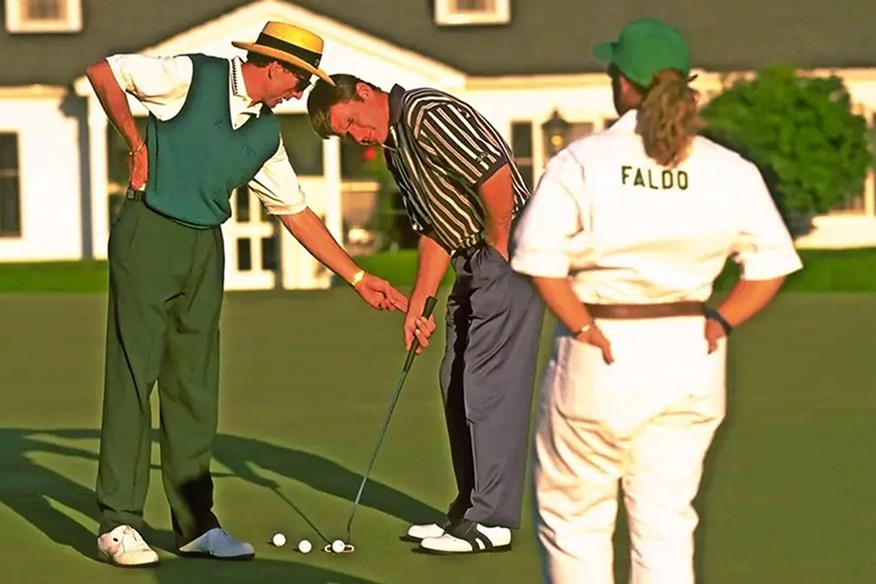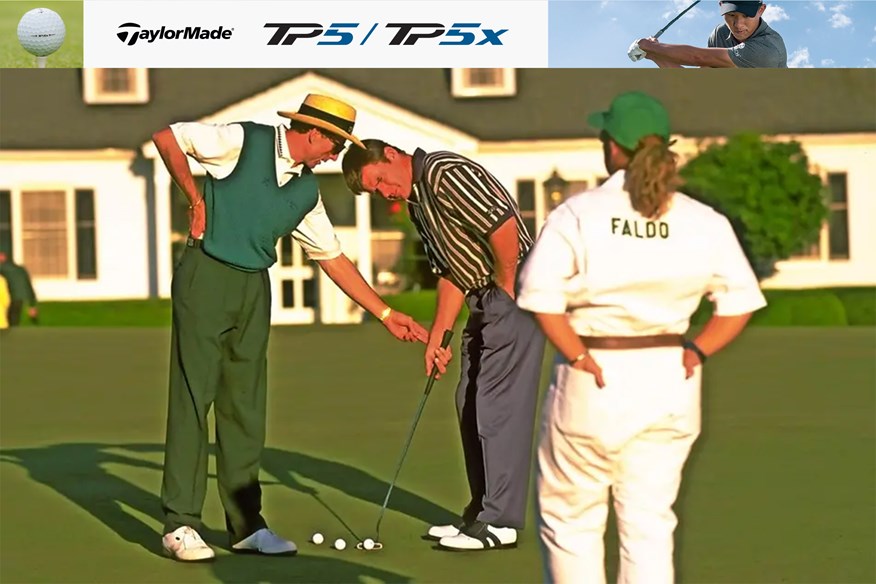Sir Nick Faldo: “My three Masters top 10s were all victories!”
Published:
Sir Nick Faldo is one of only three men to successfully defend the Masters at Augusta National Golf Club. The elite group is made up of the Englishman, Jack Nicklaus, and Tiger Woods. Here, Faldo reflects in-depth on his three career victories and what it meant to win the Green Jacket.
In terms of consistency, Nick Faldo’s Masters record makes very interesting reading. In his 23 starts at Augusta National, he posted only three Top-10 finishes and missed the cut on six occasions. But as is often the case, the numbers don’t tell the whole story. For a start, the three Top 10s were all victories.
“Isn’t that a funny stat?” Faldo, who will commentate for Sky Sports in 2023, says. “That’s how Augusta was for me. If I was doing the right things it was fine, but once the course gets to you it’s difficult to recover, even for the best players.”
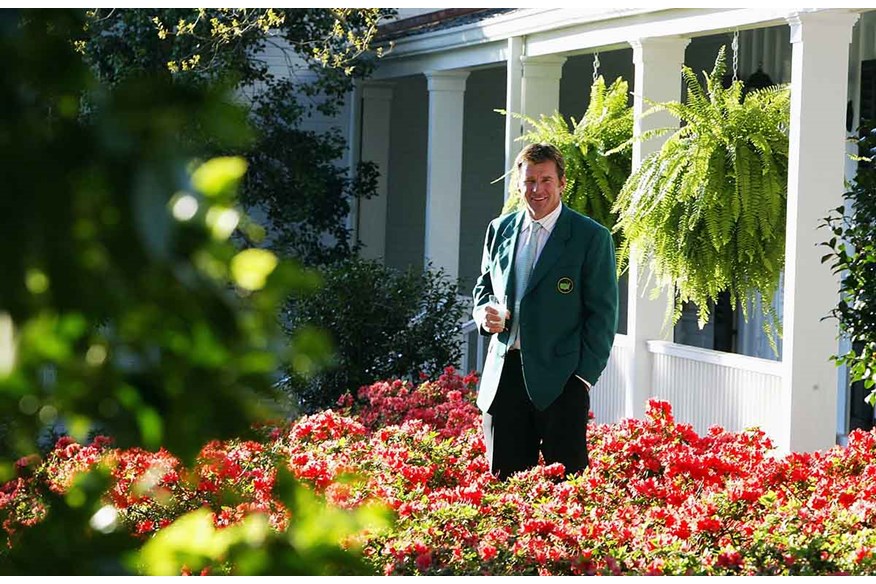
Although the golf course often came out on top in their personal battles, Faldo’s mental strength and patience enabled him to cope with the heavy demands of Augusta better than most, especially down the stretch. In each of his three victories, Faldo came from several shots off the pace over the closing holes, famously making up five shots in seven holes in 1989, chasing down Ray Floyd’s four-shot lead in 1990 and overhauling Greg Norman’s seemingly impenetrable six-shot advantage in 1996.
In a comprehensive interview, Faldo talks you through each of those Masters victories and reveals how he controlled his mind and his game to win each time.
Faldo on his 1989 Masters victory: A tale of two putts
After winning The Open at Muirfield in 1987, having previously posted four Top-10 finishes in five years, Nick Faldo’s star was in the ascendency.
After falling short over the closing stages of several majors in the early part of his career, in 1985 Faldo had overhauled his swing under the watchful gaze of David Leadbetter and become one of the world’s most consistent players.
Faldo’s status was further elevated when he lost an 18-hole play-off against Curtis Strange at the US Open at Brookline CC the following year, before finishing 3rd in his Open defence at Royal Lytham and tied 4th in the US PGA at Oak Tree in Oklahoma.
On the back of three consecutive top-five finishes in the majors, Faldo decided to dedicate himself to the PGA Tour in 1989, basing himself at Lake Nona in Florida and starting his season at the Hawaiian Open in early February. During the early part of the year, Faldo was playing nicely but a series of mistakes at crucial times saw him slip down the leaderboard on the final day.
However, he was confident his game was heading in the right direction and so, by the time he showed up at Augusta National in April, he felt confident about his chances…
“I was a little more motivated and confident than usual in 1989. Sandy [Lyle] had won the previous year to become the first British golfer to win the Masters and I remember telling myself at the time, ‘Well, if Seve and Sandy can do it, why can’t I?’
“That week, I stayed down the road at the Courtyard Marriott. My son Matthew had been born just a few weeks earlier and so I was out there with just a couple of mates. We never rented houses or had personal chefs back then. You packed your bag for three months, grabbed your clubs and off you went, often driving between tournaments to save money.
“I don’t remember too much about the practice rounds, other than it was cold and wet, and the golf course was a real brute. Early in the week, I was on the practice putting green with Jack [Nicklaus]. Jack is always nice and he asked me how I had been playing. That particular year I was playing nicely but it seemed I would always take a stupid seven or eight at a hole at the wrong time and find myself finishing in the 40s and 50s. I said, ‘You know, Jack, playing great, keep screwing up. I don’t know whether to let it happen or make it happen.’ Jack’s putting away and simply said, ‘Yeah, I know what you mean,’ and then walked off. I was like, ‘Come on, Jack, fill in the spaces, which one is it?’ I assumed from that, the answer was to just let it happen.”
The Masters that year was played in unseasonably cold, wet and windy weather, and a lot of players struggled with the difficult conditions. Faldo started slowly, but quickly got into his stride. After 27 holes, he was six-under-par and holding a three-shot lead. But then things started to slip…
“I found myself leading after 27 holes. Not only that, I’d shot my first ever sub-par round at Augusta with an opening 68 and I was starting to feel quite good about my chances. Matthew was only three weeks old, too, so it was a good time for me, personally. You become a dad and you feel amazing. It suddenly puts things into perspective. But I made the classic mistake of starting to think about things too much and I started dropping shots.”
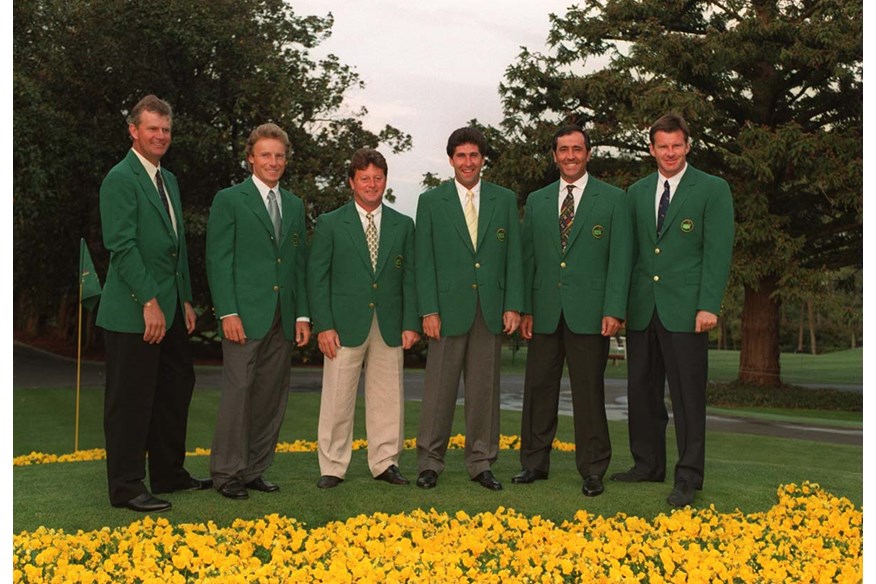
The weather didn’t improve at the weekend and a storm rolled in on the Saturday morning, delaying the start of the third round by 90 minutes. The interruption meant that several groups were left out on the course unable to complete their third rounds.
“I played with Lee Trevino on the Saturday. It just rained and rained and got darker, darker and darker. It was the round where I holed that monster putt on the 2nd green. I drove it into the trees down the left and had to chop out. Trevino hit the most amazing second shot, deliberately snap hooking a 3-wood into the left greenside bunker. I blocked my 6-iron right then holed that 100-footer across the green. I’ve still got the photo of Trevino standing there with his hands in the air.
“We were on 13 when they halted play. We’d both hit our second shots short of the green but I paced out my pitch at 56 yards before we were called in so I had it all worked out. I knew I had to hit a low skidder to get up to the top of the hill. I went straight to the range and practised my 50-yard shot and I practised it again the next morning. When we went back out onto the course, I had the distance dialled in.
“I hit the pitch just as I wanted to the back left corner but then I missed the eight-footer. That was a real let down. Then I bogeyed 14, didn’t birdie 15, and then bogeyed 17, too, after dumping my approach into the bunker. I shot 77 and finished the day two-over for the tournament. My goal at the start of the round was to get back to two-under so I was really upset – actually almost in tears – thinking I had just really blown the week.
“I came into the clubhouse, and poor old Bill Blighton, the newspaper writer, came up to me, and said, ‘What was it like out there, Nick?” I said to him, ‘Well, if you were up early in the f***ing morning, you’d have seen it!’ I really bit his head off. I did call him afterwards to apologise but it was too late, he’d already sent the story – ‘Faldo is an arse’ or something like that. They never did tell anybody that I had tried to reel it back in. That didn’t help my mood.”
At the conclusion of the delayed third round, Faldo went back to his hotel for a second breakfast and reviewed the start sheet for the final day.
Other than 1980 and 1983 Masters champion Seve Ballesteros and 1984 champion Ben Crenshaw, everybody ahead of him on the leaderboard – Mike Reid, Scott Hoch, Ken Green, Tom Kite, Greg Norman and Mark O’Meara – was looking to win their first Masters.
Having won The Open in ’87 and tied for the US Open in ’88, Faldo sensed it was far from over. But before starting his final round there was one thing he needed to sort out…
“I played with Ben Crenshaw when he won it in 1984. It was a big help because it taught me that you have to putt insanely well to win at Augusta. Watching Ben roll them in from absolutely everywhere was quite an education. I always believed, having watched all the old footage of the Masters on TV, that you had to have a good old classic putter to win at Augusta. So I put an old, bulbous Acushnet Bulls Eye in the bag and I putted nicely with it for the first few months of the season.
“However, a month or so earlier, at the Honda Classic in Florida, I had been messing around with Ken Brown on the putting green. He had a TaylorMade TPXVIII putter that I really took to. He told me he wasn’t using it and said I could try it out. I hit a few putts and thought to myself, ‘Oh, I really like this,’ but I wasn’t confident enough to put it into play at Augusta. As I headed back to the course, my one thought was to change my putter. I went to the putting green, got the TPXVIII out, wooshed a few putts and it felt great.
“Changing putter wasn’t enough to improve my mood, though. I was still cheesed off as I walked onto the 1st tee. I was playing with Larry Mize, who said to me, ‘Good luck, Nick, play nicely.’ I snarled something like, ‘Good luck? Fat chance of that!’
“I hit my opening tee shot in the trees, then my approach shot came back off the front of the green. Now I’m 45 feet away and, woof, I hole it. I birdied the 2nd, and then holed a big, curling left-to-right putt for another birdie at 4, on that front skinny pin, which is one of the iconic hole locations in all of professional golf.”
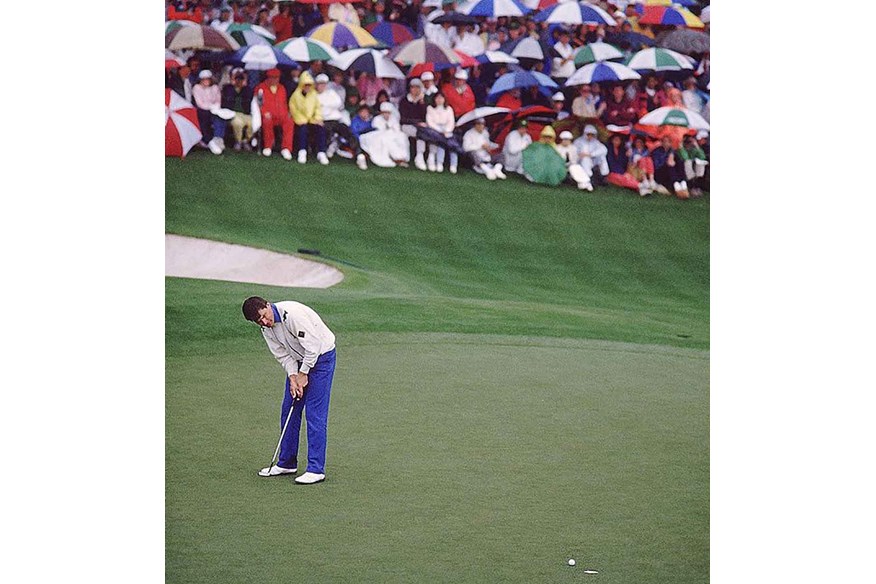
The final round was one of the most thrilling in history, with no fewer than six different players leading the tournament at one stage or other over the back nine. But with just seven holes to play, Faldo was five shots off the pace set by Scott Hoch and Greg Norman.
“I don’t remember much of the middle part of the round, but I bogeyed 11 again – the fourth day in a row. I was just grinding it out the best I could. Suddenly, though, the TV cameras started to pick me up. I hit a good drive then a fairway wood into 13 and made birdie. Can you imagine hitting a fairway wood into 13 now? They all hit mid-irons in these days. Back then, though, the par 5s were genuine three-shotters. I hit it close on 14 and made birdie there, too. But the two putts that defined the tournament came at 16 and 17.
“At the par-3 16th, I hit it to the back of the green. I had a 15-foot putt with about 12 feet of break – so much that I was standing almost sideways on to it. And I made it. That was the moment I realized I was right in it. At 17, I hit the wrong side of the ridge in the middle of the green with my approach shot. It was raining hard and so I just gave it a big slap up the hill. Bang, it went in again… kind of pure luck.
“When I reached the 18th tee, it was playing directly into the rain. I hit a good drive but still had a 4-iron in. I’ll never forget what happened next. As I was standing under the umbrella getting ready to play, a big drop of water landed right on my thumb and turned the glove into blotting paper. I thought, ‘Ugh, this is not the time to change glove.’ So I just squeezed the club a bit tighter. I hit a great shot into that front level and had a 15-footer to win it.
“It is fair to say, in that era, they didn’t like foreigners at Augusta. The patrons were making a din when I hit the putt… and I missed it. I was scooped away to Bobby Jones’ cabin and I sat there with [caddie] Andy Prodger and watched the rest of the guys come in on TV. One of the Augusta National members asked if I wanted to take a shower. I was like, ‘No, thanks, I’m just going to sit here quietly and wait.”
One by one, the field fell by the wayside. Having chipped in for birdie on 12 to take sole possession of the lead at six-under, Mike Reid missed a short putt for par on 14 and double-bogeyed 15 after hitting his approach into the water to fade to sixth place.
Seve Ballesteros, one shot back heading into 16, hit his tee shot into the water to see his chances end, while Greg Norman, who had stormed into a tie for the lead with five birdies on the back nine, was unable to get up and down from the front of the green on 18, making bogey and missing a play-off by one shot.
When America’s Scott Hoch bogeyed 17 and missed a 10-foot birdie putt at the last for victory, it was a sudden-death play-off, starting on the 10th hole.
“I skied my drive on 10 and it stuck on top of the hill on a side slope. I had 200-plus yards to the green and hit a really good 4-iron. It was only three yards right of the pin, which was right of center, but it caught the bunker. I hit a lousy bunker shot to 20 feet and thought, ‘I’m done.’
“Hoch ran his approach putt a couple of feet past the hole but, in my mind, his biggest mistake was not finishing. If he’d have turned around and said, ‘I’ll finish,’ I’d have said, ‘Fine, finish,’ and he would probably have tapped it in. Instead, I went to the side of the green and just stood there. I said to myself, ‘You know what, you can still win this, but I have to admit that it doesn’t look bloody good right now!’ I was half-expecting him to miss, though, because the putt wasn’t that easy. Just the tiniest of jiggles and it’s gone.
“At 11, I blocked my tee shot down the right. I got a drop because my ball was on a drain cover. I was miles out, though, with a right-to-left drizzle…and we were quickly running out of light. I hit a 3-iron and just nailed it. However, it was so dark that all I saw was the golf ball turning over and tipping left as it started to come down. I didn’t actually see where the ball had finished until we got to about 70 yards out. I then remember standing around on the green waiting for Scott to hit his chip, thinking, ‘It’s so dark, we can’t go to 12. I really don’t want to go to 12. What am I going to do? Am I going to have the balls here to call time out?’
“But it was Augusta National so good luck trying to tell the officials I’m stopping play for the dark! Prodg had been up ahead looking at the putt. He came back down to me and I asked him, ‘So what do you think, Prodg?’ He said, ‘It all looks a bit of a blur to me, Guv.’ I said, ‘Alright then, you go and hold the bloody flag!’
“During one of the practice rounds, playing with Mike Hulbert, I’d discovered a good putting thought. I’d got the technique down simply to ‘left-right’. Take it back with the left hand and then go through with the right hand. When I addressed the ball, I noticed I was squeezing the life out the putter. I told myself to just relax and go ‘left-right’. It was the sweetest long putt I’ve ever hit in my life… I didn’t feel a thing. Those three putts – 16, 17 and 11, I’ll never hit putts like that again.”
Because of the weather, Faldo missed out on the traditional ceremony of being presented with the Green Jacket in front of the patrons on the 18th green and was instead whisked away to a small room in the media center. Defending champion Sandy Lyle presented Faldo with the jacket.
“After I won it was just a cold and rainy pea soup. I did the Butler Cabin interview first but, in all honesty, I don’t remember any of it. You’re on such a high and dealing with so many emotions it all becomes a bit of a blur. I remember putting the Green Jacket on and noticing that it was too short in the arms. I joked, ‘It’s okay, it’s the right color!’
“You then have to go back to the club for a dinner with the members. It’s brutal. You’ve given all that energy and emotion and you’re just sitting there completely numb. Then came the stream of media commitments. I thought it would be bad PR to just fly home, even though my son had been born just a few weeks earlier, so I did a series of interviews, including one on a boat. I did treat myself, though, I flew up to Washington and took Concorde home to see little Matthew.”
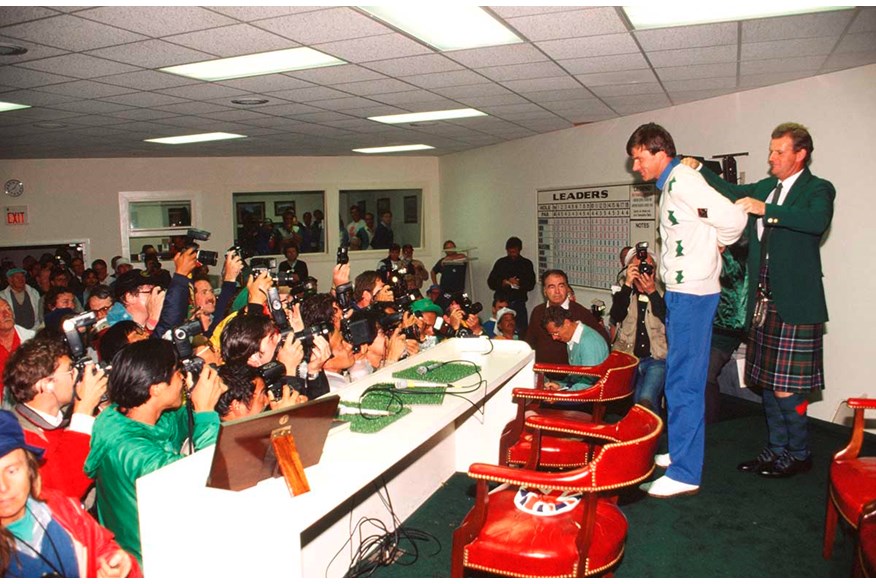
Faldo on his 1990 Masters victory: Defend of Attack
On the back of his 1989 Masters victory, Faldo went on to compile a solid season in the Majors, finishing T18 at the US Open, T11 at The Open and T9 at the US PGA.
Although by this time, Faldo had dedicated himself to performing at his best in the Major Championships, he was still living in Surrey and playing pretty much a full European Tour schedule. In fact, he would win go on to win three flagship tournaments in Europe later that year, including the prestigious Volvo PGA Championship, the Dunhill British Masters and the French Open.
However, in the first few months of the season, Faldo was struggling with his swing and feeling uneasy about defending his Masters title. He also had a new caddie on the bag – Fanny Sunesson.
“I felt very good heading into the Masters in 1989. I’d just got a new set of Mizunos, which I could hit a bit further than my previous model, and I loved them. But I was twitchy about defending and felt unsettled. I knew I had to change my mindset. Finally, I told myself, ‘Don’t think about defending. Go there and win another one.’
“Playing in the Masters that year was like a brand new experience because Fanny was there for the first time. I needed a new spark – somebody or something to get me going – and Fanny was bright, bubbly and professional. I had hired her at the beginning of the year and we went straight off charging around America. In practice, I was giving her a commentary on everything – where we wanted to go and where we didn’t want to go. It was great preparation for me, too.
“I got off to a slow start that year with rounds of 71, 72 but the course was playing tough. But my iron shots were really good and I always felt that was the key to playing well at Augusta. Then it clicked. On Saturday, I shot 66, playing with [Bernhard] Langer.”
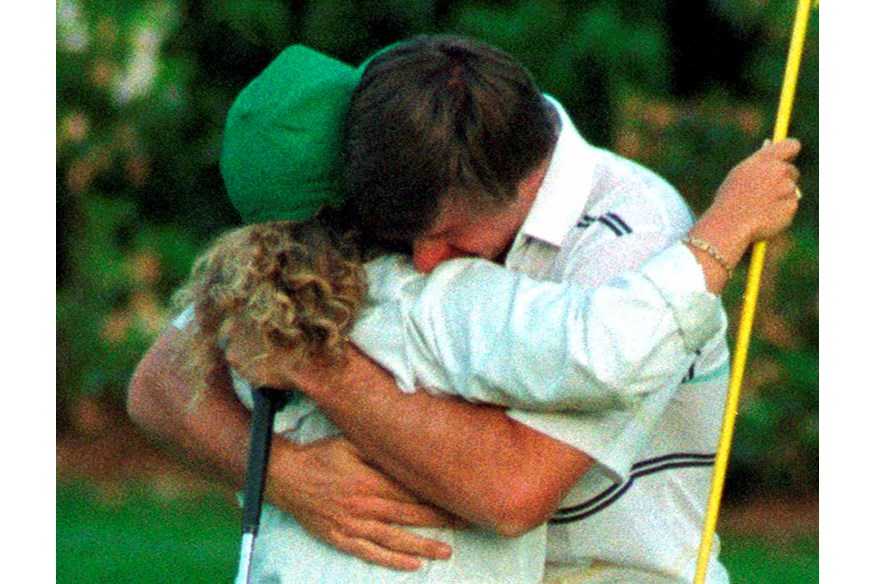
Faldo’s six-under-par round elevated him from T10 to 3rd, just three shots behind Raymond Floyd, who was leading at 10-under-par. The leaderboard was littered with star names, including Jack Nicklaus, Bernhard Langer, Seve Ballesteros, José Maria Olazabal, Tom Kite , Curtis Strange and the 1989 runner-up Scott Hoch.
“In the final round I was partnered with Jack [Nicklaus]. Standing on the 1st tee, Jack says, ‘What are you playing?’ I said, ‘Titleist 1,’ Jack says, ‘I’m playing a Titleist 1.’ There was a long silence before I eventually said, ‘Okay, I’ll play a Titleist 4, then.’ Fanny was really annoyed about that!
“I double-bogeyed the first hole. I hit it in the bunker off the tee, knocked it out, hit it onto the green and then three-putted! My mental strength kicked in here. I told myself, ‘You have to birdie the next hole. If you can do that, you can forget about that start.’ I did and I was fine from that point on.
“People have often criticised me for keeping myself to myself on the golf course. The hilarious thing is that while Jack is the gentleman of all gentlemen, he didn’t say a word. He was concentrating, of course. We didn’t talk until the 12th hole. We had both hit our tee shots and I said, ‘Thank God we don’t have to play this hole every week.’ Jack said, ‘I’ve been playing it for 32 years.’ I said, ‘That’s older than me, Jack!’
“It wasn’t looking good, but at Hilton Head the previous year, I’d taught myself a new way of playing plugged lies and had spent the whole year practicing the technique. You stick the clubhead down into the sand and half let go of the club so you get a little ‘pop’ explosion. I played the shot well but it only just about held the green – another inch and it was gone. I underhit the putt but it managed to get there…just. Making three there was a huge boost.”
Ray Floyd, who led the tournament after the 2nd and 3rd rounds, had a reputation as a solid front runner. When he birdied the 12th hole, he had a four-shot lead with just six holes to go. However, when Faldo birdied 13, 15 and 16, the lead was cut to one.
“Playing 16 in the final round was a very strange experience. I had a dream the night before that I was going to birdie the hole. When I holed the putt, I crouched down and placed my head on my putter. I had this weird feeling that I’d been there before. I played in solidly, hitting a 4-iron into 18 and safely two-putting from the back of the green through the fringe.”
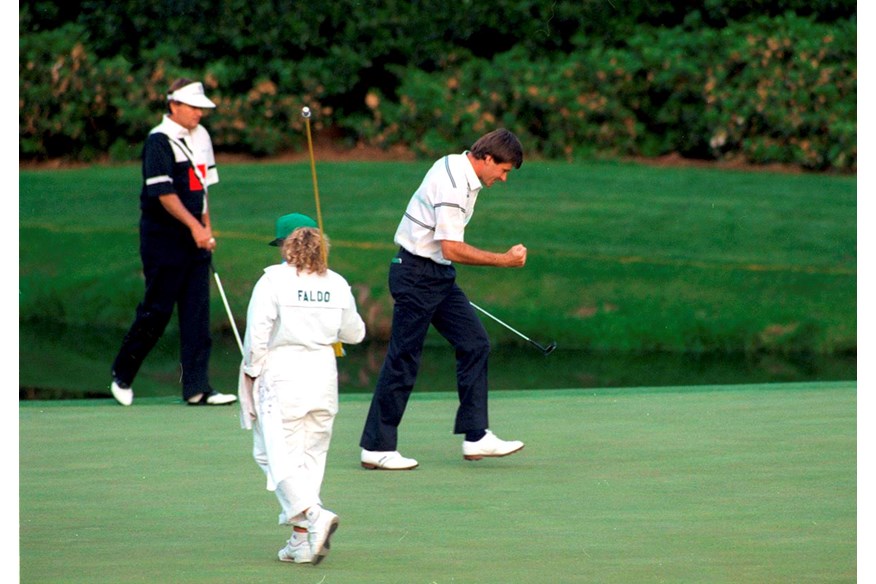
Once again, Faldo found himself watching his nearest challenger play in. When Floyd pulled his approach shot on 17 and made bogey, and then failed to make a birdie at the last, the pair finished the tournament at 10-under-par.
“Just as I had done in ’89, I skied my tee shot down 10. I hit a good 4-iron in but, as I had done the previous year, found the right hand bunker. This time, though I hit a really good bunker shot. I felt that sent a strong message to Floyd that I was okay. Even so, Floyd had hit a good approach shot in and he had a 15-footer to win it. It was quite an easy putt but he left it short. Floyd was gutted afterwards. He couldn’t believe it because he was super confident. I think he really thought he was going to hole that putt.
“The fairway on 11 was drier than in 1989. My drive flew way past Floyd’s but as I walked to my ball, some strange thoughts popped into my head. Because of my victory the previous year, the 11th hole was the official Masters poster that year. I’d been given a poster by the artist, who had written a personal message to me at the bottom. I was thinking to myself, ‘Am I going to look at this poster for the rest of my life thinking that I won one and lost one?’ I told myself to get a grip. ‘I’m not giving up my jacket. I’m not putting my jacket on anybody else.’
“When I got down to my ball, I looked round to see what was going on, but Floyd had disappeared. He had gone to the rest room, which I thought was a bit weird. I saw him arrive at his ball and by the time I looked back again, he had hit his shot. I couldn’t believe he had hit it so quickly.
“When I saw he had hit it in the pond, my brain went fuzzy. I was trying to work out what it meant, how many he was going to take, what would he score if he chipped it in… but I couldn’t do the maths. I decided to hit a little three-quarter 8-iron. It was a defensive, hold off shot aimed about six feet right. It finished six feet short and six feet right. After Floyd chipped on, I knew I had two putts to win, so it was a mega lag from about 10 feet.”
In winning in 1989 and 1990, Faldo became the first player since Jack Nicklaus (1965/66) and only the second in history – to win consecutive Masters. Tiger Woods joined the elite club in 2001/02. Whether he can do so again in 2020 remains to be seen.
“Matching Jack’s achievement was very special. After I holed the winning putt, I was kind of hoping that Jack Nicklaus would present me with the Green Jacket but I wasn’t sure if I should suggest it or not. It would have been cool. Maybe 30 years on, I’ll suggest it!”
Faldo on his 1996 Master victory: Battling the Demons
Heading into the 1996 Masters, Nick Faldo was struggling, both personally and professionally.
A year earlier, Faldo’s separation from his wife, Gill, had turned into a tabloid media frenzy while, on the course, Faldo hadn’t won a major since the 1992 Open at Muirfield.
In 1995, Faldo decided to base himself full-time in the United States in order to better prepare for the three majors played on American soil. Although he won the Doral Open in Miami that year and finished runner-up in the Mercedes Championship at the beginning of ’96, there was little to suggest he would claim a third Green Jacket when he arrived at Augusta in April.
“Of all my competitive rounds, the one people want to talk to me about the most is the 67 on the final day of the 1996 Masters with Greg Norman. I’ve lost count of the number of times people have come up to me and commented on how calm and confident I looked that day. In truth, I was fighting inner battles with my swing and my mind the whole week. Throughout the final round, I was constantly having to step in and out of focus, prepare and re-prepare to hit each shot as I fought to rein in Greg’s lead and keep my swing under control. It’s the greatest round I’ve ever played mentally.
“On the first practice day, I headed to the 10th tee. I skied my drives at 10 and 11. It was an inauspicious start, not helped by Jerry Pate walking past and saying, ‘That’s too quick, too fast.’ My swing thought for the rest of the week was to slow my swing down for a ‘softer’ transition. I liked having a catchphrase to help keep me focused. Thanks to my daughter, Georgina, I swung the club with the thought ‘Powerpuff Girls’ in my head. I was keeping it all soft and trying not to ‘burst the bubble’ through impact.
“All of my thoughts were designed to keep my swing smooth. So you can imagine what I thought when I was paired with John Daly in the first round. But to my surprise, I played all right and shot 69, which did me the world of good. However, Norman had opened with a nine-under-par 63, so I was already six shots back. A 67 in the second round moved me up to second, four behind Greg, who I was then paired with on the Saturday afternoon.”
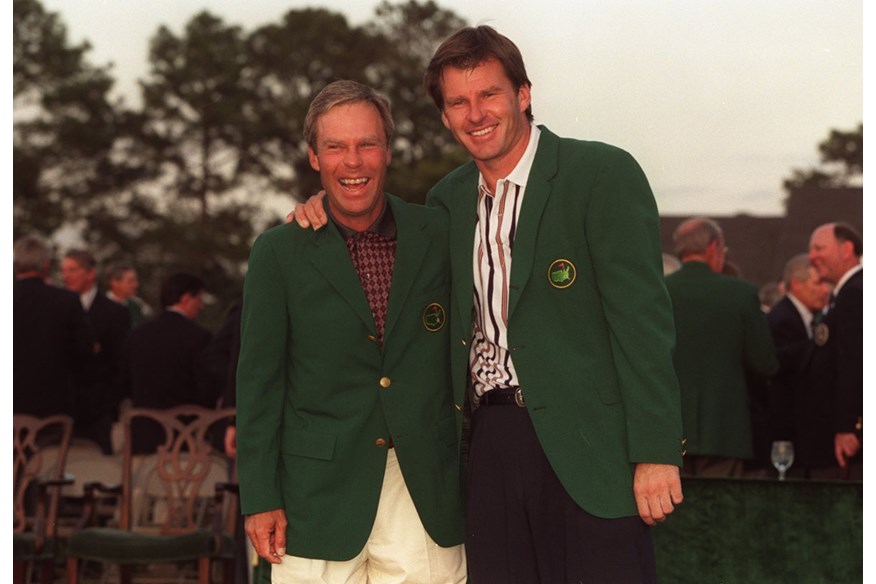
The conditions were tough for scoring over the weekend and Faldo’s 73 to Norman’s 71 meant he now trailed the Australian by six shots again. Importantly, as it turned out, Faldo had done just enough to ensure that he would play in the final group alongside Norman again on Sunday.
Unhappy with his game, Faldo delayed talking to the press after the third round and headed straight to the range to try and sort things out.
“My expectations on Sunday were very optimistic. Greg had a big lead, but sometimes that can add to the pressure and make things harder. Ed Sneed had led by five in 1979 and was unable to get the job done. I told myself that if I could get within three, I might have a chance. At the 1st hole, Greg pulled his tee shot and dropped a shot. The deficit was now five. As we stood on the second tee, I watched as he regripped his club 12 times at address. He didn’t seem comfortable and that moment gave me confidence.
“My tee shot on the par-3 6th was another massive swing in my favour. I’d just bogeyed 5, but I managed to find the top plateau six feet behind the hole with my tee shot. Any time you execute that shot well you feel you’re in sync with your irons. Two back at the turn, the 10th was another big momentum changer. Greg pulled his 8-iron then jammed his chip. There seemed to be only one direction this was all going. He was 10-under and I was nine-under. I could see he was in trouble.
“I can remember standing on the top of the hill at 11, with the green protected on the left by water, and thinking, ‘Now would not be a good time for the wheels to come off’. It’s one of the toughest shots you can face at Augusta. Negative thoughts like that are not really what you need when you’re feeling the pressure in the final round of a major, but I was constantly having to reassess what I was trying to do.
“I’d come into the week fishing about for a swing, but I’d found one and I was determined not to make a mistake. Deep down my confidence wasn’t at its best, but I knew how to prepare myself mentally before I stepped up to the ball.”
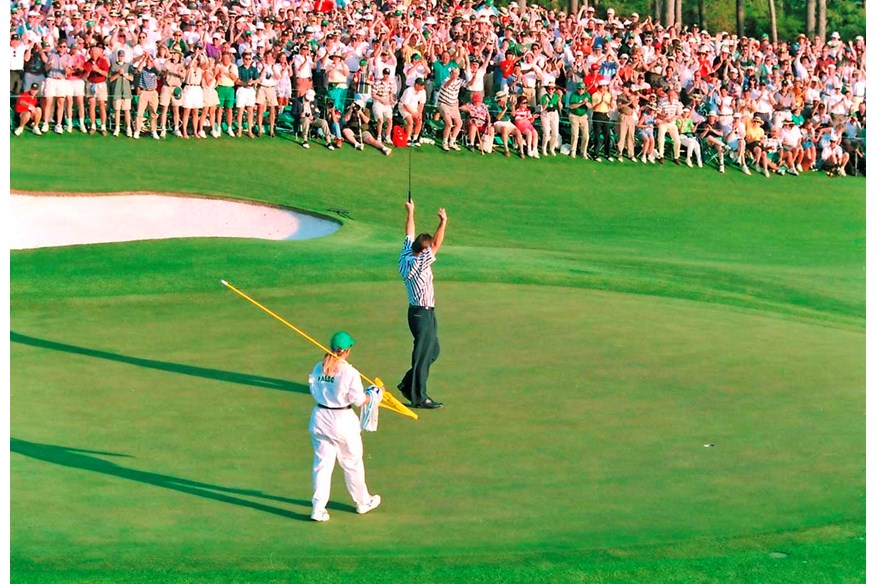
Faldo hit a solid 8-iron into 11, leaving himself a fairly simple uphill putt of about 15 feet. Norman also hit a good approach, pin-high right. But the Australian’s 10-foot birdie putt slid past the hole and he missed the four-footer coming back. When Faldo tapped in for his par, the pair were tied at nine-under par. Norman’s six shot lead had disappeared in just 11 holes.
“We stood on the tee at the 12th hole nine-under apiece. It was really all square, though, because it had become pure matchplay. And what do you do in matchplay when it’s your honor on a par 3? You find the green. I was nervous hitting that knock down 7-iron because you never really know what’s going to happen. I aimed for the center and hit a decent shot.
“Now It was Greg’s turn and I can imagine what was going through his mind at that point. I’d bet that he started by aiming at my ball, but then lost his discipline. And you just can’t do that on this hole. There are effectively three greens in play – left, middle and right – each one requiring a different club, so aiming middle and then pushing for the pin on the right means only one thing: water.
After hitting a solid drive round the corner at the par-5 13th, Faldo was left with a 200-plus-yard approach shot. However, the ball was lying awkwardly on an upslope and Faldo struggled to get comfortable with both his club selection and set-up.
“The drama down 13 was intense. All week I’d had a 5-wood in my bag specifically for the second shot into that green. I’d worked out that, from 215 yards, this little wood was ideal. But while it had seemed perfect in practice, I’d never had that yardage in the tournament. So what happens? Fanny says, ‘It’s 215 to the middle’. I thought, ‘Stick with the game plan’ and asked for the 5-wood. But something wasn’t right. I tried to set up to the ball only to have ‘Roses left, creek right’ going through my head. I couldn’t get comfortable, so I gave it back to Fanny.
“This highlights how strong I was mentally that week. I stopped and reassessed. ‘Let’s go from the start. How much to the front?’ It was 208, so I grabbed the 2-iron and hit a career shot. Even then, negative thoughts were lurking. Before I started my backswing, my last thought was that the water was low in the creek and if I did come up short I’d be safe on the bank!”
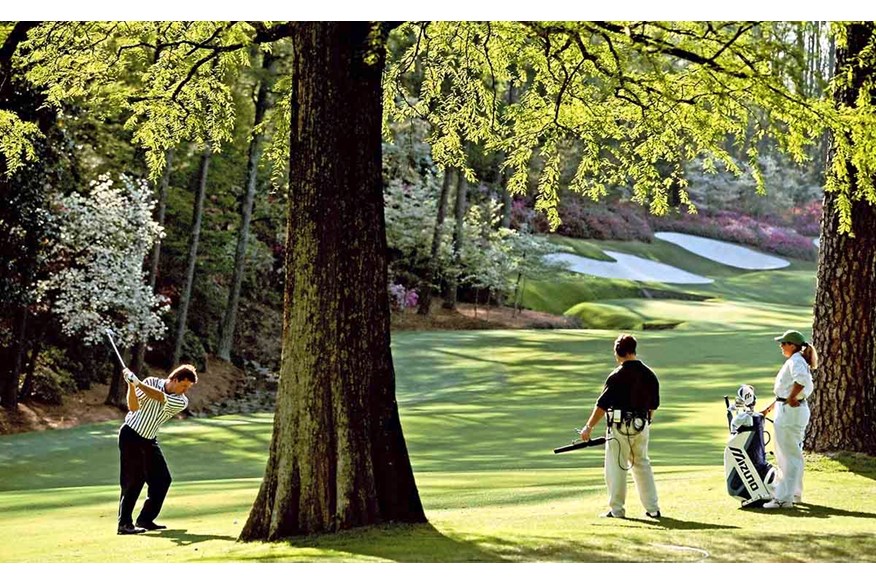
After two-putting for birdie, Faldo took a two-shot lead over Norman into the final five holes. But the Englishman was experienced enough to know the job still wasn’t done.
“Greg nearly holed his eagle chip on 15 and the pressure was right back on me to make a birdie. I’d hit my 4-iron approach heavy, which meant it had no spin and careered over the green leaving a nightmare shot back.
“Fortunately, it was a shot I had practiced a lot, working on a firm, steep jab into the ball with my weight on the left foot and my right shoulder high. It came out perfectly, checking at the top of the slope and trickling down to the hole.
“It was pure matchplay again on 16 – a case of finding the green first. I watched as Greg inexplicably dunked his ball into the lake.
“Playing 17, I wanted to maintain the four-shot lead because it was the only advantage that felt secure up the last. My tee shot on 18 found the bunker and I surprised myself how I walked straight into the sand with a 9-iron and just hit the shot without thinking. I’d been so methodical all the way round and there I was suddenly playing by instinct.
“Rolling the 15-footer in for birdie is typical when the pressure is off. I looked over at Greg. I knew what he was going to face, all the questions and criticism. I said to him, ‘I’m sorry, but I don’t know what to say.’
“Then as I gave him a hug, I thought about the media. ‘Don’t let the bastards get you down,’ I told him.”
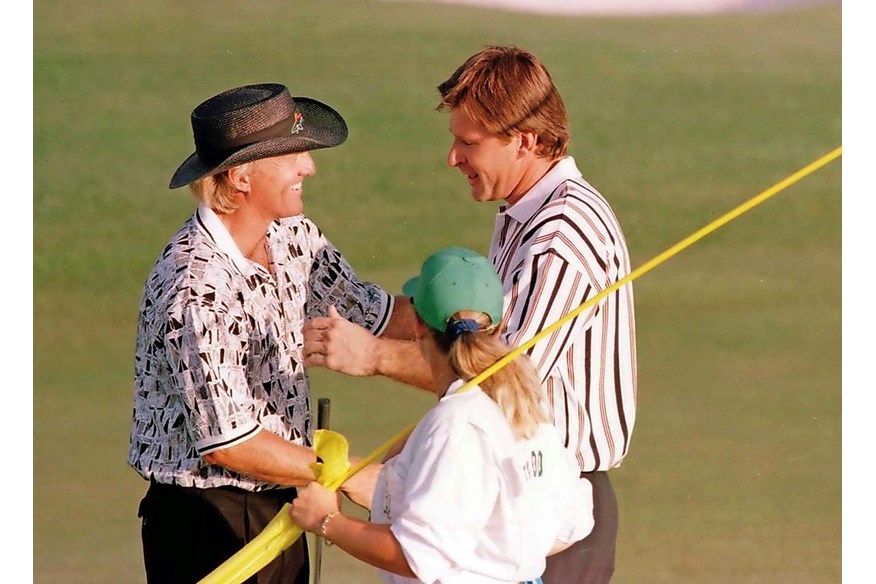
Sir Nick Faldo on his last Masters, how Rory wins and how to play Augusta National Golf Club
The moment I realized I could no longer be competitive at Augusta came on the 9th hole several years ago. My son was caddying and we were playing straight into the wind. I didn’t get down to the bottom of the hill with my drive so I was standing there with a 3-iron in my hand going, “Well, Matt, there’s no way I can hit this green. What can I do? I can’t carry it over the left, that’s impossible. I can’t hook it because it’s a downhill lie with the ball below my feet. I didn’t want to miss the green too far right because it makes for an almost impossible chip.” That was when I thought, ‘OK, well, I’m quite happy going to the TV tower now’.
I love the golf course. It’s wall-to-wall perfection. And we’re very fortunate in golf to have that special atmosphere. I arrive at the club on Saturday night and my son and I have our Sunday round. We’ve done this for eight of the past 10 years or so. I just love sitting on the back lawn, down by the umbrellas, watching the world go by.
Even if you’re churning out good shot after good shot in the right place you still have to be patient. Some shots won’t come off. You can hit a great shot at Augusta and it can just hop off the back of the green. Then you’re done. You can take four and five shots to get up-and-down without doing much wrong. If you’re a foot out with your landing area on a chip shot it can come rolling back to your feet.
Just because you have a short-iron in your hand doesn’t mean you can just take aim and fire at Augusta. If you tweak it in the wrong place or if you get that extra bounce and you miss the green, you can be in massive trouble. You’ve got to land it right on the number because the margin for error really is plus or minus a yard. If the flag is 154 and the top of the ridge is 152, you’ve got to land it between 151 and 153. Land it at 156 or 157 and you’re off to the side. Land it at 149 into the ridge short and the ball is coming back to you off the green.
When you hit some shots that do land right on the number, right where you intended, though, that’s a lovely feeling. There’s nothing like it. It’s wonderful.
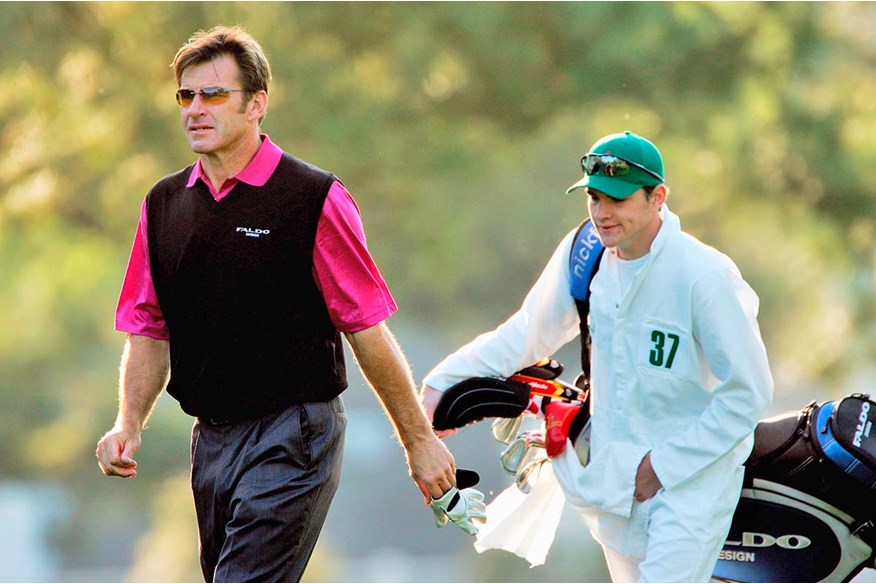
Distance control is the secret to Rory McIlroy achieving the career Grand Slam. I watched him warm-up a couple of years ago and he was striking it beautifully. Then I looked at where his 8-irons were landing and they were sometimes 15 yards apart. You’ve got to know exactly what you’re doing, so it’s a good maths game. Get your maths right and land it right on the number. But you’ve got to hit the right shape as well. You can’t say, ‘I’m going to fade it onto that spot’ and then draw it. That’s what happened to Rory a couple of times. If you’re going for a fade, you better hit a fade. If you hit the opposite, the slopes will repel the ball.
The lay-up on the par-5 2nd and 8th holes are two of the easiest shots on the golf course. Everything else demands your 100 percent attention.
In my mind, you can either be the ‘observed’ or you can be the ‘observer’. If you’re the observed, you can imagine that everybody’s looking at you. You’re standing over a putt thinking to yourself that 5,000 people around the green are watching your every move. I prefer to be the observer. That way it’s just you looking at them. Then they’re all a blur. It’s just you, in your own little world.
Brandel Chamblee has said that if you find the middle of each green at Augusta, you’re rewarded with a realistic putt, but it really doesn’t help on a lot of holes. On 1, for example, the pin is often on the left. If you land the ball in the middle of the green, a big ridge kicks it to the right. The 3rd is also a good example of when you don’t want to put the ball in the middle of the green because the slope is unbelievable. On 6, you can’t go for the middle because you have to get close to the pins in the top right and bottom left, and back left quadrants. On 7, the middle of the green is the wrong place of everything. On 8, the ball goes to the left. If the pin is on the right, your shot will keep feeding further and further away from the hole. You get my drift… So with some shots you’ve got to make the decision to be brave and go for it versus bailing out into the middle of the green.
There’s also the fear factor. If you are in the middle of the green, you’re facing downhill putts all day long, and they’re all very quick. Putting great downhill on the rock hard greens was how I won in 1996. I was very comfortable on those slick surfaces. My 67 in the final round was the low round the whole weekend, so that gives you some idea of how hard those greens were for everybody. You really had to know where you were going to land it and where it was going to stop.
Here’s how I coped with Augusta’s lightning fast greens. After I finished my round and went to the practice green for a seesion on my own I realised how you have to go so quiet you can almost hear your heart beat. You calm your breathing and you calm your grip. You have to be totally inverted, completely inside yourself. When it’s just you and the ball, you can feel it. When you’re putting that well, you can feel the cover and the weight of the golf ball. You can’t just bash putts; you have to ‘collect’ them.
Reading the greens at Augusta is like trying to read a rollercoaster. It takes experience. One of the important skills is to pay attention in your practice rounds to where the ball actually finishes. You hit a putt, it looks good, it just misses the hole and then you mentally switch off. If you paid more attention, you’d see that it actually finished eight feet past.
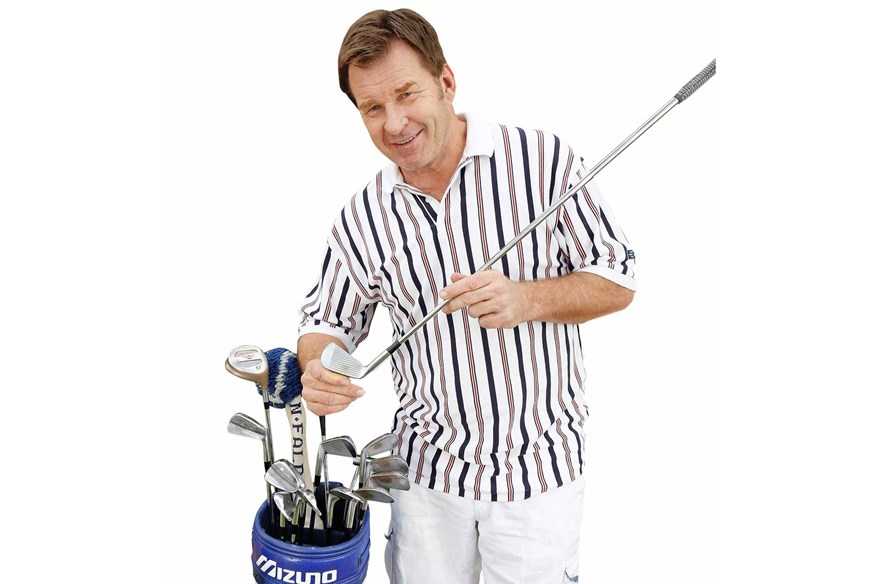
There are a couple of greens, the 1st and the 10th immediately spring to mind, where the ball breaks a mile. Double what you think. However you read it, just double it, maybe even double it again. At 10, I once had a 40-footer that broke 20 feet.
I’ve always said you should never get wound up on the greens. My mantra at Augusta was always to ensure that if I missed, I left my return putt in the right quadrant. I would wander around and say, ‘Okay, if I’m going to miss this putt, where do I want to leave the next one?’ Miss on the wrong side, or in the wrong place and even if you’re just beyond dead weight, you’ll have a left edge or right edge four-footer, or an eight-footer where you’ve got to aim two cups outside the hole. Those are tough. You’re just touching
it and hoping, hoping, it’s going to break.
It was fantastic that, even as a 21-year-old rookie, Jordan Spieth arrived at the Masters with the intention to win it. He started his preparation the end of the season before. That was a great example of the power of the mind and thorough preparation. He had a goal, he had a plan, and he executed it.
Jordan won the Masters in 2015 because his misses were great misses. He ‘necked’ his second shot on the 8th and it landed perfectly front right and the pin was back left. Had he gone with a draw and overdone it, he’d have been short-sided coming over three mounds and he’d have had no chance.
You can call it hindsight or experience, but Jordan should have teed it up again on the tee and gone again from the same spot [on 12 last year]. The other shot [from where Spieth took his first penalty drop] is a brand new shot. I think that decision cost him a couple of strokes there. He could have at worst put it on the green and made five instead of a seven. That was a huge miss.
The best way to describe the drop zone on 12 is lonesome. When you get down there, it’s just you and your caddy looking across to the green. Then you realise you’re down below the level of the putting surface and that there’s no depth perception – all you can see is water and sand. The green is just a thin pencil line. You can’t see anything. Plus, your mind is already still on the tee thinking, ‘Why did I do that?’
The great thing at Augusta is that it scares you mentally, which makes you nervous. It’s all about controlling your mind and your nerves, and facing your fears. Once the golf course gets to you, it’s difficult to recover. And it happens to even the best players. You’ll see somebody going along nicely, opening with 69, 68, and then they post an 82. You’re like, ‘Whoa, what on earth happened?’ What happened is that you hit it in the wrong place, got scared and made double. Then you walk to the next hole and all you can see is where not to hit it. Then you make seven. We have all done it. You can’t believe you lost focus so quickly.
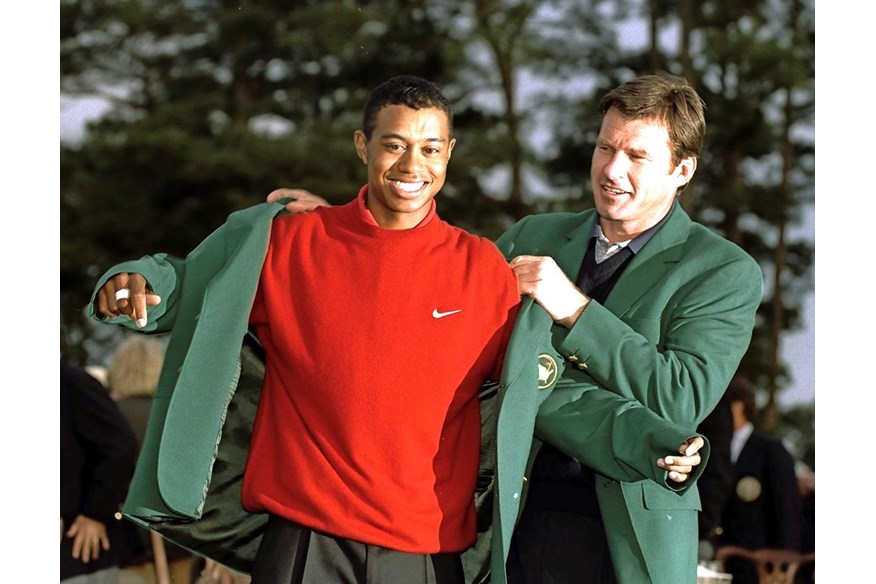
Some of the great shots at Augusta are bail-outs. If you don’t like the pin position, you’ve obviously got to move your target but it can still mean you’ve got to carry a false edge or a false front and stop it before it goes over the back.
A lot of people talk about having a game plan, but I wouldn’t call it that at Augusta because it really is one shot at a time.
You’re often only trying to carry the ball one or two yards with a chip off a very tight lie at Augusta. I used to practise hitting one-yard chip shots. Just pop it forwards. Then I’d move up to two yards and then three yards until I had full control. Why? If you’re a yard off with your landing spot, suddenly you’re 10 feet from the hole. You’ve also got little chips where you have to go sideways, let the ball U-turn and feed down to the hole.
People talk about the modern players overpowering Augusta, but they forget you still have to be very clever. The beauty of the golf course is that, at times, the player going in with a 5-iron has an advantage over the player who has a wedge in his hands.
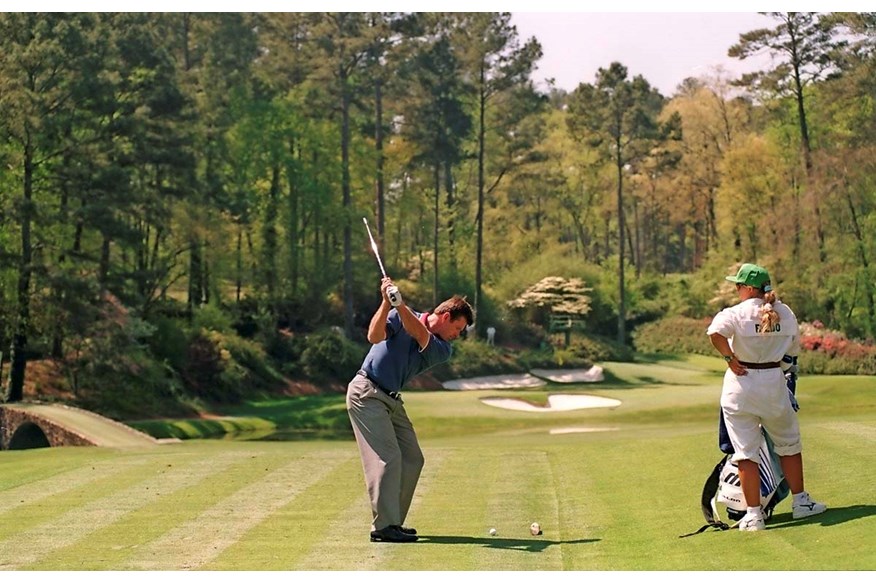
Sir Nick Faldo on the three skills that every would-be Masters champion needs
1. Master your distance control with irons
Playing Augusta National is like taking a maths test. You’ve got to know your numbers and exactly how far you’re hitting each club, because the margins for error are so tiny. I would always spend a lot of time on real distance work, hitting irons shots and knowing exactly how far they carried. I also wanted to know that I could hit fades and draws at will.
2. Do your preparation and your homework
Augusta National presents a unique challenge and you have to be fully prepared by the time you arrive. You can’t show up on the day and try to learn the shots you need. I was always thinking about the Masters, ticking off little boxes in my head in the three or four events before the tournament. I’d be asking myself if my short game was good enough, or if I was comfortable enough playing the bunker shots I’d need to be able to hit. Certain chip shots were worth practicing too.
3. Control your green speed
There have been times in the past when the greens have been incredibly quick. On some of the short putts, it’s almost impossible to make a short enough stroke because you only need to make the ball turn over once. I would use my right thumbnail as a guide. I’d focus on moving my thumb a half-inch or an inch to make the putter move two. That trick worked very well for me.
-
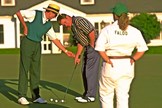 Why Sir Nick Faldo considers a top 10 finish to be a Masters victory worth celebrating.
Why Sir Nick Faldo considers a top 10 finish to be a Masters victory worth celebrating.
-
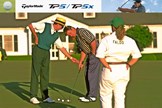 Nick Faldo Masters champion.
Nick Faldo Masters champion.
-
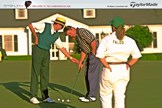 Nick Faldo won the Masters in 1989, 1990 and 1996
Nick Faldo won the Masters in 1989, 1990 and 1996
-
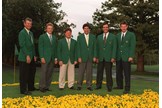 Europe enjoyed a highly successful run at the Masters in the 80s and early 90s.
Europe enjoyed a highly successful run at the Masters in the 80s and early 90s.
-
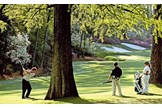 Nick Faldo's career shot... the famous 2-iron.
Nick Faldo's career shot... the famous 2-iron.
-
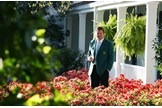 Sir Nick Faldo in one of his Green Jackets at Augusta's iconic clubhouse.
Sir Nick Faldo in one of his Green Jackets at Augusta's iconic clubhouse.
-
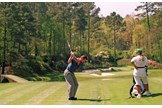 Mastering distance control is key to success at Augusta, according to Nick Faldo.
Mastering distance control is key to success at Augusta, according to Nick Faldo.
-
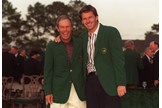 Nick Faldo is all smiles with Ben Crenshaw after receiving the Green Jacket in 1996.
Nick Faldo is all smiles with Ben Crenshaw after receiving the Green Jacket in 1996.
-
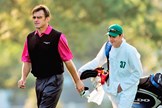 The year Nick Faldo realised he could no longer compete at Augusta.
The year Nick Faldo realised he could no longer compete at Augusta.
-
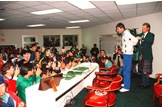 Nick Faldo receives his Green Jacket from Sandy Lyle in 1989.
Nick Faldo receives his Green Jacket from Sandy Lyle in 1989.
-
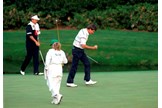 Faldo on his way to a successful Masters defence in 1990.
Faldo on his way to a successful Masters defence in 1990.
-
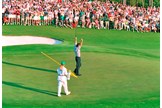 Faldo celebrates at the Masters in 1996.
Faldo celebrates at the Masters in 1996.
-
 Nick Faldo with the 2-iron that helped him to victory in 1996.
Nick Faldo with the 2-iron that helped him to victory in 1996.
-
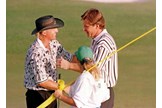 Nick Faldo consoles Greg Norman after winning the 1996 Masters.
Nick Faldo consoles Greg Norman after winning the 1996 Masters.
-
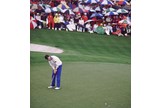 Nick Faldo produced some wonderful putting at the 1989 Masters.
Nick Faldo produced some wonderful putting at the 1989 Masters.
-
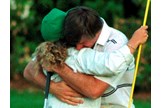 Faldo celebrates with caddie Fanny Sunesson in 1990.
Faldo celebrates with caddie Fanny Sunesson in 1990.
-
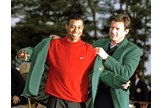 Faldo had a close-up view of Tiger Woods' brilliance at the 1997 Masters.
Faldo had a close-up view of Tiger Woods' brilliance at the 1997 Masters.
